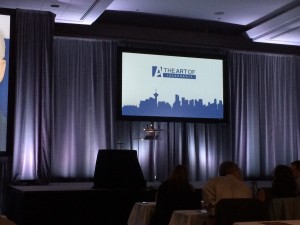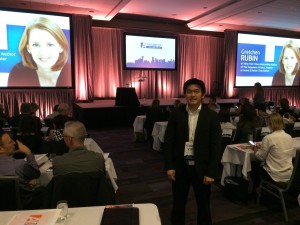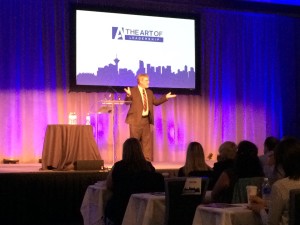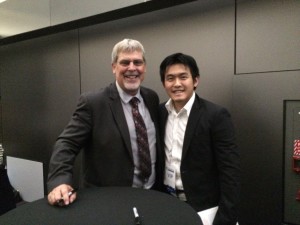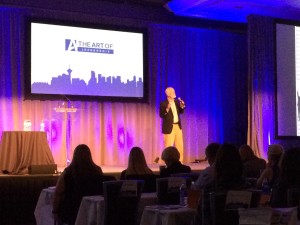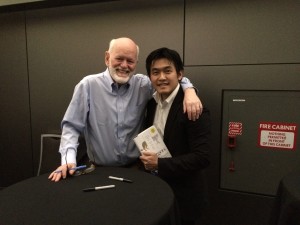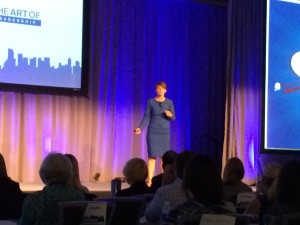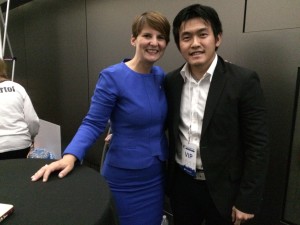The Art of Leadership Vancouver 2015
Date: September 14, 2015
Name: The Art of Leadership Vancouver 2015
Presenters: Gretchen Rubin, Captain Phillips, Marshall Goldsmith, Dr. Liane Davey, and Colonel Chris Hadfield
The world is craving for new leadership. The world is looking for guidance. Everything in leadership is about action. The Art Of, the leading media and event company, presents their signature event “The Art of Leadership” to discuss the meaning of leadership in today’s world. This conference invites Gretchen Rubin, Captain Phillips, Marshall Goldsmith, Dr. Liane Davey, and Colonel Chris Hadfield to share their leadership style and experiences. This presentation will impact many leaders who are looking for inspiration and innovation. Moreover, leaders will learn the strategy to lead a better team in their organizations.
The Art of Leadership believes it is important to stand beyond the product and stand for community. Leaders must realize people are looking for emotional connections. People will not care about organization values unless there are connections. Leaders should remember to be a rebel with a cause and do not just say it, live up to it. In addition, organizations do not change, people change, so leaders should take the inspiration and do something about it.
“Principle is just principle when it costs money”
Gretchen Rubin
The author of “The Happiness Project”, Gretchen Rubin draws the concept of habits and believes habits can lead people to be happier and healthier. Habits can be considered as self-commends.
Many people are fascinated with habits, but it can cause people frustration. A majority of people think certain attitudes can lead to similar habits. Overall, Rubin believes habits is the architecture of life, which can shape people’s presents and future.
The key of habits is decision making. It allows people to make decision and create self control. Rubin emphasizes any type of actions from people are already decided a long time ago. People can change habits. Habits can be changed by first understanding the habits. People need to discover what is the truth for them.
Rubin shares 2 types of strategies to change the habits.
The first strategy is the strategy of abstaining. Leaders must make decisive decision. All decisions can be either or. There is no between. Rubin calls people who are making indecisive decisions the moderator. They change all the time. Leaders must be abstained, not moderated.
The second strategy is the strategy of treat. Many leaders conceptualize treat as reward. Treat is not a reward, it is a want. Treat can give self charge and they must be healthy treat. Many bad habits are created when there is unhealthy treat, such as food or scream plan. Instead, leaders should consider health treat, such as music. Health treat can give people the feeling of desire.
Many leaders create satisfaction when they accomplish a goal. However, they are not happy at all. This is caused by leaders believing the goal is the finish line. When leaders treat goals as milestone, they will find their satisfaction from the process of their accomplishment.
Rubin shares her theory of 4 tendencies in life: upholders, questioners, obligers, and rebels. Each tendency has their own ways to meet their expectation. Upholders are uneasy and they lock in to their expectation. They accept rules and they meet deadlines. Questioners have the characteristic of good organization skills. They tend to question everything. They love research and they can drain and frustrate people around them.
Obligers can meet expectation, yet they also have outer accountability. They use outer expectation to control inner expectation. Moreover, they are easy to be burned out because they do too much work. Lastly, rebels think outside of the box. They are not afraid to do things differently; however, they can be hard to demand. There is more pressure and resistance from rebels. They have the characteristic of wanting to prove to the world.
Rebels and obligers can have strong long relationship. Rubin emphasizes each tendency is not categorized by the type of gender. They are personality and it is format for leaders to understand more about others. All tendencies can have weakness in the organization. Base on patterns of habits, people can determine their tendency type. When leaders can change their habits, they can change their lives.
“Tendency is not just looking at other people, it is the reasoning that differentiate the tendency”
Captain Phillips
The author of “A Captain’s Duty”, Captain Phillips will share his leadership experience as a sea captain.
Phillips shares his journey began at a cab experience. After graduating from school, Phillips faced the problem of not knowing what to do in life. Phillips started his career as a taxi driver in order to gain outside experience. One day, Phillips was inspired from a sailer in his cab; afterwards, he decided to sail.
His ship is called “Maersk Alabama”, and the life of a sailer is very different. Phillips mentions the life of sailer is the cycle of 90 days on the ship, and 90 days home. Philips is the captain and the captain is not a part of the crew; instead, captain takes care of the crew.
Phillips shares 3 major leadership lessons.
- Leaders are stronger than they think
- Failure only viable if leaders give up
- Teamworks work together can solve problems
Phillips believes leadership has the major component of imagination. Imagination can enhance leaders experience.
Phillips indicates the biggest problem for any sea captain is the pirate attacks. Pirates can highjack captain’s ships. While on the ship, Phillips started to discuss all the possible problems with his crew. Later he discovered some crew members are not familiar with some primary functions. Phillips believes leaders must allow their crew to come up with great ideas and talk it through to ensure everyone is on the same page.
Phillips shares the experience of his pirate attack. The ship was about to face a pirate attack. Even though everyone was terrified, they knew what to do. Phillips believed there is always a way out from any danger. When pirates aboard the ship, they were controlling the ship. Unfortunately, they could not find the rest of the crew. Pirates forced Phillips to call them out from the PA system, but because of prior training, the crew would not show up without the right secret phase.
Taking care of the crew was the primary responsibility for Phillips. It will take baby steps to gain back the ship control. After negotiation, Phillips was forced to be on a life boat that led the ship. Phillips realized in leadership, people cannot solve new problem with the old system. Phillips negotiated with the pirates, but the negotiation failed.
Because of the humid temperature, Phillips played the mind game and discovered the opportunity to jump out from the window. At the right moment, Phillips made the attempt but failed. Phillips had faith that someone will rescue them. When US Navy arrived, the pirates realized the odd is changing. Phillips jumped out of the window again and US Navy took the opportunity to control the ship. Phillips and his crew were alive.
“Well trained professionals can overcome any obstacles, running will not, see it through”
Marshall Goldsmith
One of the best New York Times bestselling author and world-renowned leadership expert, Marshall Goldsmith believes creating behaviour that lasts will help leaders to become the person they want to be.
Traditionally, many executives are ashamed to hire executive coach. However, the trend is changing. Goldsmith believes there are many behaviours that are easy to understand, but they are hard to do.
People know who they want to become, so they follow them. However, in reality, million of people come with the result of discharged or dissimulated. Goldsmith emphasizes this is all because of trigger. Trigger is any stimulus that may impact behaviour. When triggers happen, leaders are in control. There are two types of controls: internal and external. Internal control gives leaders the feeling of creating the world, and the external control give leaders the feeling of the world is creating them. When there is a lack of control on both internal and external, they will be in random state. If leaders have both control, they are called “mutual creation”, which means they feel they can create the world and at the same time, the world is creating them.
Triggers lead to impulse, and later turn to behaviour. Goldsmith believes there should be another step, which is impulse leads to awareness then behaviour. Triggers can have negative and positive impacts. Moreover, it is important for leaders to be aware of triggers.
Goldsmith indicates the world has many distractions, such as email, television and social media. For most people, the biggest distraction is their dream. When leaders believe it is just a dream, they will treat it only like a dream.
“For most people, dream is their biggest distraction”
There are many reasons why leaders are not doing and are distracted. The first reason is that leaders think planning and doing are separate. The second reason is the understanding gap. The third reason is that it will not take long to do. The forth reason is the high probability of low probability distractions. The fifth reason is treating it as special day. The sixth reason is to believe leaders have the wisdom and courage to objectively evaluate their own behaviour. The seventh reason is leaders believe they have the willpower that will not deplete. The last reason is they do not admit they need help or structure their goals.
Goldsmith wants leaders to feel it is normal to ask for help and structure. The role of coaching is different in this world. Instead of fixing losers, leaders help winners. Many athletes, movie stars and other world leaders have multiple coaches. If leaders can fix it by themselves, they would probability be fixed by now. Goldsmith recommends leaders to change the behaviour of expecting their team to come up with solutions. It is all right to come without solutions.
Leaders tend to have ego and they are too proud of them. Ego will get in their way. Leaders must understand that the important factor of changing is to change the client, not the coach. Leaders should never make coaching about their own ego. If people do not care or if leaders do not care, they should not waste time. Leaders should not tell others what they need to become because people will change if they want to.
Goldsmith shares the 4 key wheel of change: creating, preserving, eliminating, and accepting.
Creating is for leaders to know who they want to create. Leaders should create that person that they want to become. Preserving is for leaders to preserve what they want. This means to have gratitude for their past and continue to seek future challenges. Eliminating is for leaders to eliminate what they want. Leaders know what to eliminate and when to eliminate. Lastly, accepting is for leaders to learn to accept present. Leaders should let go of their past by forgiving and accept the environmental limitations with prioritizing their actions.
Whenever leaders are struggling to make any decision, Goldsmith suggests leader to answer this question.
“Am I willing at this time to make the investment required to make a positive difference on this topic?”
If leaders answer yes, they should go for it. If not, they should let it go. Leaders should always question why the process works and how the process works. Leaders should make a list of active and passive questions. Active question focuses on what they can do to make a positive difference for them and the world. The passive question focuses on what the world needs to do to make a positive difference for them. When leaders answers these questions daily, they will see a pattern of their behaviours.
Goldsmith suggests 6 active questions.
- Are you happy?
- Did you find the meaning?
- Are you fully engaged?
- Are you building positive relationship?
- Are you setting clear goals?
- Are you making progress towards goal achievements?
Goldsmith wants leaders to be happy, help others, and do what they think it is right.
Dr. Liane Davey
The author of “You First: Inspire your team to grow up, get along and get stuff done”, Dr. Liane Davey shares most organizations are facing dysfunctional teams.
The sad reality of teams is that when revenue are declining, it shows the impact. The impact of the employee base affects from top to bottom positions. Senior management teams are losing faith and have many disagreements. Employees realize the management is not doing right. Employees are frustrated and they are bring the depression back to their families. Davey believes this is toxic. Toxic means something is wrong but leaders are not aware of it.
Davey mentions 5 different kinds of toxic teams.
Team Toxic #1: Crisis junkieitis
When there is stressful time, it will influence teams. There are four major elements that need to form in the team.
- Role clarity
- Priority
- Resources
- No politics
When any of these four major elements is missing, leaders will give up and wait for crisis to join up. This shows this kind of toxic will force people to get things done when there is a crisis.
Team Toxic #2: Royal Rumble-osis
Team can be filed by passion, but they show low EQ. Teams with this kind of toxic are aggressive. They debate back and forth, and nothing will happen. This kind of toxic will force the team to find new engagement.
Team Toxic #3: Bleeding back trauma
People believe if there is nothing nice to say, do not say anything at all. These kind of people are lacking of conflict skills. This will slow down the process of decision making in any team. This will also cost teams their money, time and energy.
Team Toxic #4: Bobble heads
People do not risk to think differently. When they compromise, they get rewards. This kind of toxic forces people not to have any obligation to disagree. When they do not get comfortable, they will show things down.
Team Toxic #5: Spectator syndrome
People in this team work individually. They only have direct conversation with their manager. People feel they will only say things they care for themselves. There is no team chemistry and no one is managing the risk.
In reality, many leaders use the quick fix method of conducting team building options or tissue meeting to assemble the team together, but it will not solve the problem.
Davey believes the most important thing is to change team member behaviours. There are 3 types of characters in any team. Either they are wicked people, who are being aggressive, wounded people, who are being underwater, or witness people, who are doing nothing at all.
After discovering the characteristic of each team members, Davey shares 5 solutions to fix the problem.
Solution #1: Start with a positive assumption
Brain use s neutral system that filters the negatives. When people thinks about negative emotions or feelings, they will feel hostel. Davey suggests leaders to be aware of any assumptions they make and open up with curiosity.
Solution #2: Amplifying other voices
Many teams ignore other who are not thinking the same. Minority people are not in the voice of majority people. Therefore, leaders tend to block out of minority ova and tend to devalue them. Davey wants leaders to give full attention to the minority and involve them to the conversation.
Solution #3: Know when to say no
Good team players will say yes, but they will tell the trust in the team. When teams say too much “yes” can create bad and negative atmosphere. Davey recommends leaders to think about if the statement is worth the time to do before say the word “yes”. After saying no, leaders can provide reasons and alternative solution. Leaders need to allow others to become the contributor.
Solution #4: Embrace productive conflict
People need to get into different mindset. Leaders should stop thinking what is right or wrong; instead, leaders should start understand the truth behind the conflict. Leaders need to validate the outcome and reinforce back to the team. Instead of creating tug-or-war, leaders need to create a feeling of Allie for others. Davey wants leaders to say it with friendly way.
Solution #5: Time to change
Leaders need to open the option to change. Leaders need to decide the actions and make it obligation to change. Davey expects leaders to get good feedback. Good feedback makes up of the situation, behaviour of others, subjective, and make it like the feedback is theirs.
“Get comfortable being uncomfortable”
Colonel Chris Hadfield
The first astronaut and first Canadian Commander of the International Space Station, Colonel Chris Hadfield, defines leadership as the art of influencing human behaviour to accomplish mission in matter of desire leaders. Leaders lead people, and they get people to change what is next. Passion can lead to dictate.
Hadfield states the odd of dying on spaceship is one out of thirty-eight. It is still an amazing feeling for Hadfield. Spaceship experience gives Hadfield the change to live through a process to ready for taking risk.
Hadfield emphasizes he always questions himself what could be the next thing that will kill them. In his leadership style, focus is the key. Leaders can be overwhelmed by distractions, but there is no problem that it will make it worst than in space. Hadfield believes leaders must have a balance. A balance of focus what is important and recognize the right actions.
When the spaceship launches to space, Hadfield feel powerless. The 7 pounds of thrust ignites over 80 million horse power in a tube of explosive, and Hadfield describes it as the feeling that people put cement on him. The eight minutes and 32 seconds is the time he feels weight less.
How do Hadfield organize and lead?
Hadfield believes leaders need to direct themselves first. Leaders must identify the perfection in their teams. This means leaders should imagine if everything is in ideal condition, what would they need to do.This will create common objectives and construct long term definition of perfection. Life is the sequence of choice of what leaders make next.
Hadfield will break down the tasks to sub tasks. Sub tasks will lead to perfection. In space, Hadfield had the experience to see the world. With one glance, it snaps him the set of skills and rewards.
After conducting the long term goals, leaders need to build personal competence. People will follow leaders with competence. Moreover, leaders need to gain competence. Even if leaders have perfect something, there is always something changing. Therefore, Hadfield suggests leaders to remember not to satisfy their current competence. Leaders should always continue to grow.
In order to get his team ready, Hadfield needs to prepare them the ability to solve anything. By training together, they know what skills are required. Hadfield has 4 statements he wants his team to remember in space.
- Survival
- Health of vehicle
- Love the experience
- Science done for NASA
Culture can be an issue for leaders. Hadfield bridges the gap by clearly state the objectives for his team. Afterwards, he lets lose and check for progress.
First time in space
Hadfield shares his first experience in space. His first assignment was to help Russian to build shelter that connect to the dock. Hadfield led his team by visualization and practice for years. Hadfield instructed his team to visualize failure. When they knew what the most likely to go wrong, they will practice for it.
“People are busy to visualize failure, but leaders will do it anyway”
Everything could break in space. A spark happened and Hadfield required immediate action. Hadfield and his team were required to perform space walk. The incident was out of his control, but he believed his team because they are prepared for the worst. In leadership, Hadfield gave a part of his ship away as a decisional authority. By giving decisional authority to others will help them enhance their decision abilities. At the end, his team members, Chris and Tom, completed the task.
Hadfield thinks they did not save the station by luck, it is all because of proper preparation. Leaders prepare their skills, which will give them the right confidence. The leadership principles work with everything in life. Because of leadership, people have the ability to create new innovative machines, software enhancement, and other technology.
Therefore, Hadfield’s leadership contains 3 factors.
- Define goals
- Give skills
- Turn loose
Hadfield mentions the biggest problem they are facing is launching. 50% of all the risk is at the first 9 minutes of launch. Currently, many people are finding ways to make the launch faster, safer, and cheaper.
The CEO of Tesla, Elon Musk, believes it is possible to retrieve the rest of the rocket for reuse. This will improve the launch and landing and reduce costs. So far the experiment is still in progress.
Hadfield believes early success is bad because it reinforce failure. Leaders want things to fail early to gain insight for improvement. Leaders have responsibility to his team. When they make the next decision, they are responsible for the next. The leaders in this generation have the responsibility to nutrient the next generation.
Hadfield mentions when they return to earth, it feels like a meter. They use the soft landing rocket, made by Russia, to help them out. Hadfield starts with an impossible quest, but he made it possible.
The next phase for Hadfield is to live proud and interesting. He will educate other people with his experience and help other become better leaders.

